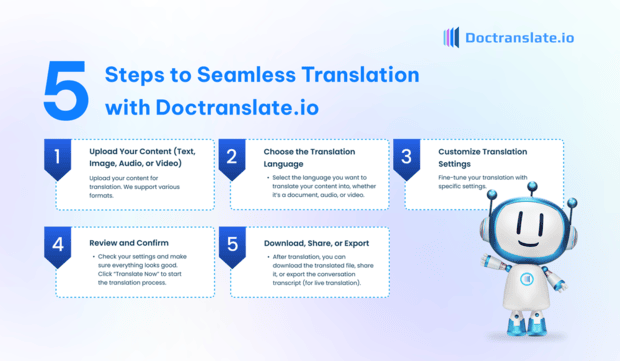Introduction
Connecting with a wider audience often requires overcoming language barriers. Translating social media posts is crucial for sharing your message globally.
Whether you’re an individual or a business, reaching English speakers from a Tagalog (Filipino) base is vital. It helps grow your influence and engagement significantly.
Manually translating posts can be time-consuming and might miss cultural nuances. This is where an efficient tool becomes essential.
Doctranslate.io offers a simple yet powerful solution for translating your Tagalog (Filipino) social media content into English, ensuring accuracy and speed.
Step-by-Step Guide: Translating Social Media Posts from Tagalog (Filipino) to English with DocTranslate.io
Step 1: Input Your Content
To begin the **translation process**, first access the platform. You can easily sign in with your Google account or register using your email and password.
New users are welcomed with 5 free credits upon registration, allowing you to start immediately. Navigate to the text translation feature.
For your social media post, copy the text written in Tagalog (Filipino). Paste this text directly into the designated text box on the **DocTranslate.io Text Translate** page.
The system handles text up to 5000 words, perfect for various post lengths. This ensures your complete message is captured for translation.
Step 2: Choose the Translation Language
Once your content is ready, the next step is to select your target language. Find the language selection options provided on the page.
Choose ‘English’ from the extensive list of available languages. **DocTranslate.io** supports over 85 languages for versatile translation needs.
Make sure the input language is set to ‘Tagalog (Filipino)’. This tells the system the source language of your text.
Selecting the correct source and target languages is vital for accurate results. Double-check your choices before proceeding.
Step 3: Customize Your Translation Settings
**DocTranslate.io** allows for customization to tailor the output. For text translation, you have several options.
You can adjust settings like font style, size, and color for the output text. These formatting options help match the original look or suit your preference.
Consider using the bilingual translation option. This displays the original Tagalog (Filipino) text alongside the English translation.
While domain and tone settings are available for some translation types (like documents or images), the text translation interface focuses on formatting and direct text output. Utilize the available options to perfect your translation.
Step 4: Review and Confirm
Before initiating the translation, take a moment to review your settings. Check that the input text is correct and complete.
Confirm that ‘Tagalog (Filipino)’ is the source language and ‘English’ is the target language. Look over any formatting choices you’ve made.
Ensuring all settings are correct prevents errors in the final output. This step is crucial for achieving the desired result.
Once you are satisfied with the setup, click the ‘Translate Now’ button. The system will begin processing your request.
Step 5: Download, Share, or Export
After the **translation process** is complete, your English translation will be ready. The platform provides options for accessing your translated content.
You can typically download the translated text directly. This allows you to copy and paste it back into your social media platform.
For other content types like documents or videos, download options include various file formats. Text translation usually provides the output within the browser interface, ready for copying.
Simply copy the translated English text from the output box. You can now paste it into your social media post to share with your English-speaking audience.

Beyond Text: Translating Other Social Media Elements
Social media posts aren’t just text. They often include images, videos, or audio.
**DocTranslate.io** also offers tools to translate these elements. This allows you to make your multimedia content accessible too.
You can use the **Image Translate** feature for graphics with text. Or try **Audio Translate** or **Video Translate** for spoken content or subtitles.
Expanding your translation efforts beyond text ensures your entire social media presence resonates globally. Explore these features for comprehensive reach.
Conclusion
Translating Social Media Posts from Tagalog (Filipino) to English has never been easier. **DocTranslate.io** provides the tools you need for accurate and efficient translation.
By following these simple steps, you can break language barriers effectively. Reach a broader audience and increase your engagement.
Remember that **DocTranslate.io** supports various file types and media, not just text. You can translate documents, images, audio, and video too.
Ready to connect with the world? Start translating your content today and experience the benefits. Visit **DocTranslate.io** to get started!


Leave a Reply